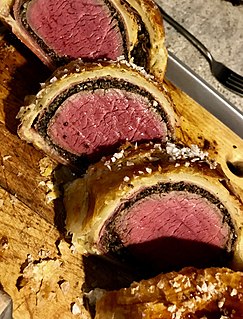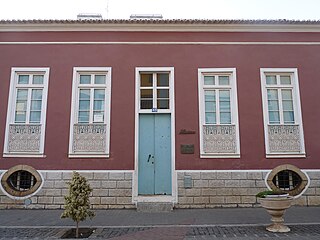Related Research Articles

Meatloaf is a dish of ground meat that has been mixed with other ingredients and formed into the shape of a loaf, then baked or smoked. The final shape is either hand-formed on a flat pan or created by cooking it in a loaf pan. It is usually made with ground beef, although ground lamb, pork, veal, venison, poultry and seafood are also used.

Chateaubriand is a dish that traditionally consists of a large center cut fillet of tenderloin grilled between two lesser pieces of meat that are discarded after cooking. While the term originally referred to the preparation of the dish, Auguste Escoffier named the specific center cut of the tenderloin, the Chateaubriand.

Steak tartare is a meat dish made from raw ground (minced) beef or horsemeat. It is usually served with onions, capers, pepper, Worcestershire sauce, and other seasonings, often presented to the diner separately, to be added for taste. It is often served with a raw egg yolk on top of the dish.

Churrasco is the Portuguese and Hispanic name for beef or grilled meat more generally. It is a prominent feature in the cuisine of Brazil and its South America Hispanic neighbour countries Uruguay, Bolivia, Argentina, Guatemala, Colombia, Nicaragua, Peru, Chile and other Latin American countries. The related term churrascaria is mostly understood to be a steakhouse.

Beef Wellington is a pie made of fillet steak coated with pâté and duxelles, which is then wrapped in parma ham and puff pastry, then baked. Some recipes include wrapping the coated meat in a crêpe to retain the moisture and prevent it from making the pastry soggy.

Bistek or bistec is a Spanish loan word derived from the English words "beef steak" abbreviated.

Cachupa is a famous dish from the Cape Verde islands, West Africa. It is a slow cooked stew of corn (hominy), beans, cassava, sweet potato, fish or meat, and often morcela. Referred to as the country's national dish, each island has its own regional variation. The version of the recipe called cachupa rica tends to have more ingredients than the simpler, cachupa pobre.

Morro Negro is a hill located near the east coast of the island of Boa Vista, Cape Verde. Its elevation is 156 m. The nearest village is Cabeça dos Tarrafes, 5.5 km to the northwest.

Pot roast is a braised beef dish made by browning a roast-sized piece of beef before slow cooking the meat in a covered dish, sometimes with vegetables, in or over liquid. Tougher cuts such as chuck steak, boneless chuck steak, short ribs and 7-bone roast are popular cuts for this technique. While the toughness of the fibers makes them unsuitable for oven roasting, slow cooking tenderizes the meat as the liquid exchanges some of its flavor with the beef. The result is tender, succulent meat and a rich liquid that lends itself to gravy.

Steak-frites, meaning "steak [and] fries" in French, is a very common and popular dish served in brasseries throughout Europe consisting of steak paired with French fries. It is considered by some to be the national dish of Belgium, which claims to be the place of its invention.

A steak is a meat generally sliced across the muscle fibers, potentially including a bone. Exceptions, in which the meat is sliced parallel to the fibers, include the skirt steak cut from the plate, the flank steak cut from the abdominal muscles, and the silverfinger steak cut from the loin and including three rib bones. In a larger sense, fish steaks, ground meat steaks, pork steak, and many more varieties of steak are known.

Steak and oyster pie, also known as beef and oyster pie is a traditional Victorian English dish. It is also known in Australia and New Zealand. In Ireland, it has been prepared by the Ballymaloe House, and as a classic dish of the Ballymaloe Cookery School. In the United States, it's a regional dish of Norfolk, Virginia. There, neck, flank, round, or rump may be used. It is prepared in a Dutch oven, where it is slow-cooked until gelatinous. Steak and oyster pie may be made with bluff oysters, and may use brewed, alcoholic beverages, such as ales and stouts. This dish is also prepared by Rick Stein using Guinness beer.

Museu Etnográfico da Praia is an ethnographic museum in the Cape Verdean capital of Praia on the island of Santiago. It is located at 45 Rua 5 de Julho, in the historic part of the city, the Plateau. The museum was opened in November 1997 and is located in a 19th century building. The museum contains a selection of objects that represent the traditional uses and customs of the Cape Verdean people.

Praia Baixo is a village in the southeastern part of the island of Santiago, Cape Verde. It is part of the municipality of São Domingos and the parish of Nossa Senhora da Luz. It is situated on the east coast, 1.5 km northwest of Achada Baleia, 11 km southeast of Pedra Badejo, 10 km east of São Domingos and 16 km north of the capital Praia. In 2010 its population was 952.

Ervatão or Porto de Ervatão is a beach on the southeast coast of the island of Boa Vista in Cape Verde. At its eastern end is the headland Ponta de Ervatão. Ervatão is part of the Turtle Nature Reserve. The area of Ervatão receives 70% of all turtles nesting on Boa Vista. In July 2009, 8,000 turtle nests were counted.

The cuisine of Cape Verde is a West African cuisine largely influenced by Portuguese, Southern and Western European and West African cuisine. Cape Verde was a colony of Portugal from its colonization until 1975.
The Culture of the Island of Santiago, Cape Verde is the richest in the nation, with a range of customs and practices common in the islands,
The following lists events that happened during 2002 in Cape Verde.
References
- ↑ Cherie Y. Hamilton, "Os sabores da lusofonia: encontros de culturas", Senac 2005, ISBN 85-7359-407-1
- ↑ "Cabo Verde: Tartarugas marinhas ameaçadas de extinção em menos de dez anos - RTP Notícias". ww1.rtp.pt. Archived from the original on 2012-02-29. Retrieved 2008-07-07.